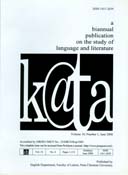Understanding Domestic Violence in Indonesia Through a Play-with-music: A Story of Wounds
Abstract
The number of domestic violence is 50% out of violence against woman cases in Indonesia. This condition is intriguing to analyse. There must be a reason behind rising number of crimes related to inequality of women position in the society. One of the ways that can be used to reflect on this subject is through theatre. It is a work of art that can be used to discuss and inspire a necessary social change or social agenda. Therefore, applying textual analysis method on A Story of Wounds, a play by Jessie Monika, I would like to find the reasons behind that inequality to find the core problem of domestic violence as portrayed in ASoW. I utilize Bourdieu’s capital, habitus and field theory to prove that inequality between the wife and the husband, the deeply rooted patriarchy values create imbalance power that open opportunity for domestic violence toward women.
Downloads
References
Anderson, L. W., Krathwohl, D. R., Airasian, P. W., Cruikshank, K. A., Mayer, R. E., Pinrich, P. R., Raths, J., & Wittrock, M. C. (Eds.). (2001). A Taxonomy for Learning, Teaching, and Assessing. Longman, Inc.
Arivia, G. (2006). Feminisme Sebuah Kata Hati. Kompas. Jakarta.
Arya, A. (2020). An Overview of Textual Analysis as a Research Method for Cultural Studies. International Journal for Innovative Reserach in Multidiciplinary Field, 6(3), 173–177.
Bourdieu, P. (2001). Masculine Domination. Stanford University Press. California. p.177.
Bourdieu, P. (2013). Outline of A Theory of Practice. Cambridge University Press. https://doi.org/10.1590/S0103-20702013000100001
Bourdieu, P. (1986). The Forms of Capital. In Richardson, J., Handbook of Theory and Research for the Sociology of Education (pp. 241–258). CT: Greenwood. https://doi.org/10.4324/9780429494338
Fitriyani. (2018). 5 Kasus KDRT di Indonesia Paling Miris, Ada yang Sampai Jual Istri. Oke News. https://nasional.okezone.com/read/2018/01/12/337/1844191/5-kasus-kdrt-di-indonesia-paling-miris-ada-yang-sampai-jual-istri
Gamble, S. (2001). Postfeminism. In S. Gamble (Ed.), Feminism and Postfeminism (pp. 36–45). Routledge.
Hains, R. C. (2009). Power Feminism, Mediated: Girl Power and the Commercial Politics of Change. Women’s Studies in Communication, 32(1), 89–113. https://doi.org/10.1080/07491409.2009.10162382
Harker, R., Mahar, C., & Wilkes, C. (1990). An Introduction to the Works of Pierre Bourdeau (R. Harker, C. Mahar, & C. Wilkes (Eds.)). Palgrave Macmillan.
Hilgers, M., & Mangez, E. (2015). Introduction to Pierre Bourdieu’s Theory of Social Fields. In M. Hilgers & E. Mangez (Eds.), Bourdieu Theory of Social Fields (p. 446). Routledge.
Komnas Perempuan. (2021). CATAHU 2020 Komnas Perempuan: Lembar Fakta dan Poin Kunci (5 Maret 2021). Laman Komnas Perempuan. https://komnasperempuan.go.id/siaran-pers-detail/catahu-2020-komnas-perempuan-lembar-fakta-dan-poin-kunci-5-maret-2021
Lally, E., Ang, I., dan Anderson, K. (Ed.). (2011). The Art of Engagement. The University of Western Australia Publishing.
McKee, A. (2003). Textual Analysis A Beginner’s Guide (p. 156). SAGE Publications Ltd.
McKenna, J. (2014). Creating community theatre for social change. Studies in Theatre and Performance, 34(1), 84–89. https://doi.org/10.1080/14682761.2013.875721
Monika, J. (2018). A Story of Wounds. English Department. Petra Christian University.
New Play Development. (2013). Petra Little Theatre. https://petralittletheatre.wixsite.com/petralittletheatre/new-play-development
Pamungkas, A. (2018) Ajak Masyarakat Melawan Kekerasan Lewat A Story of Wounds. https://fti.petra.ac.id/news/ajak-masyarakat-lawan-kekerasan-lewat-a-story-of-wounds
Rindawati. (2010). Habitus dan Ranah: Proyek Intelektual Pierre Bourdieu Membangun Teori Struktural Genetik. In S. Bagong & M. . K. Amal (Eds.), Anatomi dan Perkembangan Teri Sosial (pp. 419–442). Aditya Media.
Rogers, M. F., & Swartz, D. (1999). Culture and Power: The Sociology of Pierre Bourdieu. Contemporary Sociology, 28(2), 234. https://doi.org/10.2307/2654908
Smith, J. (2017). Textual analysis. In J. Matthes (Ed.), The Internatuional Encyclopedia of Communication Reserach Method. John Wiley and Sons, Inc. https://doi.org/10.4324/9781315519296-4
Sulistyani, H. D. (2012). “Korban dan Kuasa” di dalam Kajian Kekerasan Terhadap Perempuan. Forum, 39(2), 20–24. https://ejournal.undip.ac.id/index.php/forum/article/view/3153
Sweetman, P. (2009). Revealing habitus, illuminating practice: Bourdieu, photography and visual methods. The Sociological Review, 57(3), 491–511.
Syawitri, M., & Afdal, A. (2020). Analisis Faktor-faktor yang Mempengaruhi Relasi Kuasa Pelaku Kekerasan dalam Rumah Tangga (KDRT). JPGI (Jurnal Penelitian Guru Indonesia), 5(1), 37. https://doi.org/10.29210/02598jpgi0005
Wuriyani, E. P. (2020). Mengenalkan Pemikiran Pierre Bourdieu untuk Sastra. Jurnal Edukasi

This work is licensed under a Creative Commons Attribution 4.0 International License.
This work is licensed under a Creative Commons Attribution License





















